实时定量PCR引物和探针设计操作步骤Primer Express软件
- 格式:doc
- 大小:1.06 MB
- 文档页数:13
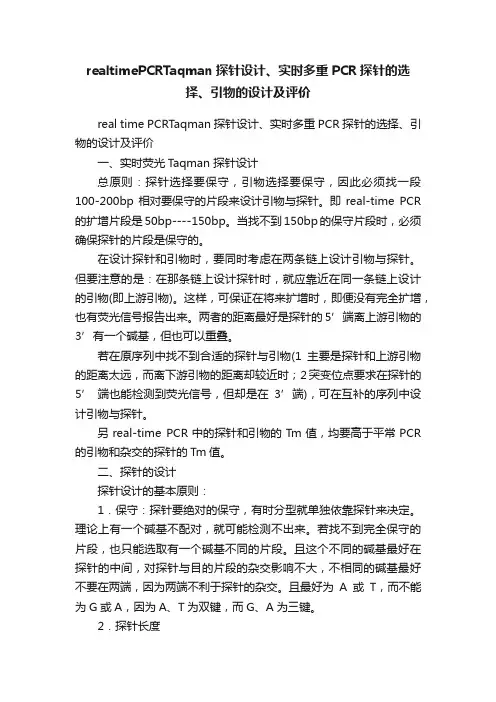
realtimePCRTaqman探针设计、实时多重PCR探针的选择、引物的设计及评价real time PCRTaqman探针设计、实时多重PCR探针的选择、引物的设计及评价一、实时荧光Taqman 探针设计总原则:探针选择要保守,引物选择要保守,因此必须找一段100-200bp相对要保守的片段来设计引物与探针。
即real-time PCR 的扩增片段是50bp----150bp。
当找不到150bp的保守片段时,必须确保探针的片段是保守的。
在设计探针和引物时,要同时考虑在两条链上设计引物与探针。
但要注意的是:在那条链上设计探针时,就应靠近在同一条链上设计的引物(即上游引物)。
这样,可保证在将来扩增时,即便没有完全扩增,也有荧光信号报告出来。
两者的距离最好是探针的5’端离上游引物的3’有一个碱基,但也可以重叠。
若在原序列中找不到合适的探针与引物(1主要是探针和上游引物的距离太远,而离下游引物的距离却较近时;2突变位点要求在探针的5’ 端也能检测到荧光信号,但却是在3’端),可在互补的序列中设计引物与探针。
另real-time PCR中的探针和引物的Tm值,均要高于平常PCR 的引物和杂交的探针的Tm值。
二、探针的设计探针设计的基本原则:1.保守:探针要绝对的保守,有时分型就单独依靠探针来决定。
理论上有一个碱基不配对,就可能检测不出来。
若找不到完全保守的片段,也只能选取有一个碱基不同的片段。
且这个不同的碱基最好在探针的中间,对探针与目的片段的杂交影响不大,不相同的碱基最好不要在两端,因为两端不利于探针的杂交。
且最好为A或T,而不能为G或A,因为A、T为双键,而G、A为三键。
2.探针长度Taqman探针的长度最好在25-32bp之间,且Tm值在68-72℃之间,最好为70℃,确保探针的Tm 值要比引物的Tm值高出10℃,这样可保证探针在煺火时先于引物与目的片段结合。
因此探针最好是富含GC的保守片段,保证其的Tm值较高。
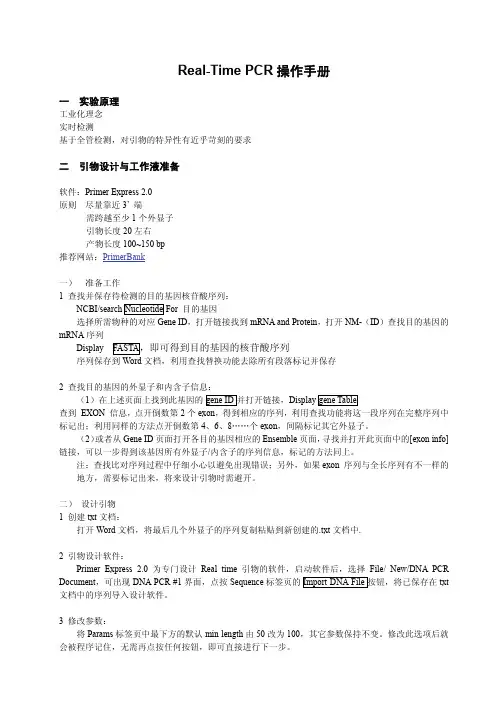

半定量和实时定量PCR步骤实验原理:RT-PCR将以RNA为模板的cDNA合成同PCR结合在一起,提供了一种分析基因表达的快速灵敏的方法。
RT-PCR用于对表达信息进行检测或定量。
另外,这项技术还可以用来检测基因表达差异或不必构建cDNA 文库克隆cDNA。
RT-PCR比其他包括Northern印迹、RNase保护分析、原位杂交及S1核酸酶分析在内的RNA分析技术,更灵敏,更易于操作。
RT-PCR的模板可以为总RNA或poly(A)+选择性RNA。
逆转录反应可以使用逆转录酶,以随机引物、oligo(dT)或基因特异性的引物(GSP)起始。
RT-PCR可以一步法或两步法的形式进行。
在两步法RT-PCR 中,每一步都在最佳条件下进行。
cDNA的合成首先在逆转录缓冲液中进行,然后取出1/10的反应产物进行PCR。
在一步法RT-PCR中,逆转录和PCR在同时为逆转录和PCR优化的条件下,在一只管中顺次进行。
实验步骤:Trizol法RNA提取步骤1、提取总RNA2、逆转录反应3、PCR反应以下实验步骤仅供参考:1 样品RNA的抽提①取冻存已裂解的细胞,室温放置5分钟使其完全溶解。
②两相分离每1ml的TRIZOL试剂裂解的样品中加入0.2ml的氯仿,盖紧管盖。
手动剧烈振荡管体15秒后,15到30℃孵育2到3分钟。
4℃下12000rpm离心15分钟。
离心后混合液体将分为下层的红色酚氯仿相,中间层以及无色水相上层。
RNA全部被分配于水相中。
水相上层的体积大约是匀浆时加入的TRIZOL 试剂的60%。
③RNA沉淀将水相上层转移到一干净无RNA酶的离心管中。
加等体积异丙醇混合以沉淀其中的RNA,混匀后15到30℃孵育10分钟后,于4℃下12000rpm 离心10分钟。
此时离心前不可见的RNA沉淀将在管底部和侧壁上形成胶状沉淀块。
④RNA清洗移去上清液,每1mlTRIZOL试剂裂解的样品中加入至少1ml的75%乙醇(75%乙醇用DEPCH2O配制),清洗RNA沉淀。
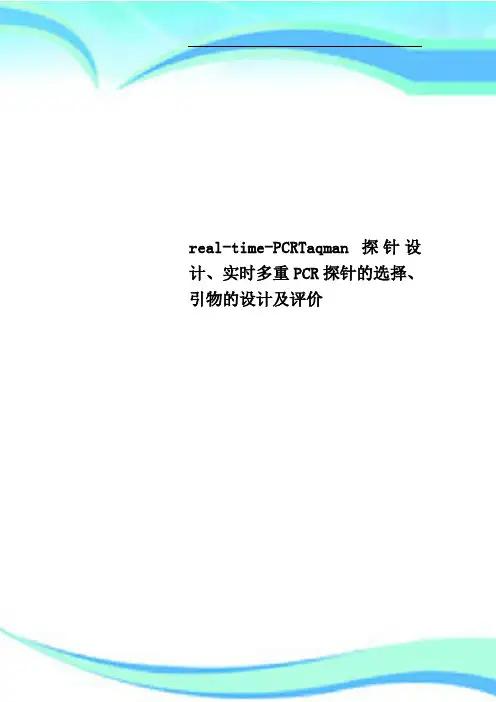
real-time-PCRTaqman探针设计、实时多重PCR探针的选择、引物的设计及评价————————————————————————————————作者:————————————————————————————————日期:real time PCRTaqman探针设计、实时多重PCR探针的选择、引物的设计及评价一、实时荧光Taqman 探针设计总原则:探针选择要保守,引物选择要保守,因此必须找一段100-200bp相对要保守的片段来设计引物与探针。
即real-time PCR的扩增片段是50bp----150bp。
当找不到150bp的保守片段时,必须确保探针的片段是保守的。
在设计探针和引物时,要同时考虑在两条链上设计引物与探针。
但要注意的是:在那条链上设计探针时,就应靠近在同一条链上设计的引物(即上游引物)。
这样,可保证在将来扩增时,即便没有完全扩增,也有荧光信号报告出来。
两者的距离最好是探针的5’端离上游引物的3’有一个碱基,但也可以重叠。
若在原序列中找不到合适的探针与引物(1主要是探针和上游引物的距离太远,而离下游引物的距离却较近时;2突变位点要求在探针的5’ 端也能检测到荧光信号,但却是在3’端),可在互补的序列中设计引物与探针。
另real-time PCR中的探针和引物的Tm值,均要高于平常PCR的引物和杂交的探针的Tm值。
二、探针的设计探针设计的基本原则:1.保守:探针要绝对的保守,有时分型就单独依靠探针来决定。
理论上有一个碱基不配对,就可能检测不出来。
若找不到完全保守的片段,也只能选取有一个碱基不同的片段。
且这个不同的碱基最好在探针的中间,对探针与目的片段的杂交影响不大,不相同的碱基最好不要在两端,因为两端不利于探针的杂交。
且最好为A或T,而不能为G或A,因为A、T为双键,而G、A为三键。
2.探针长度Taqman探针的长度最好在25-32bp之间,且Tm值在68-72℃之间,最好为70℃,确保探针的Tm 值要比引物的Tm值高出10℃,这样可保证探针在煺火时先于引物与目的片段结合。

用Primer Express软件来设计比较方便、简单。
网上搜索一下,我记得有网友提供的。
如果实在找不到这个软件的话,可以参考下面的指南。
先设计好Probe,再设计Primer。
good luck。
Design GuidelinesEnsure the following guidelines are met:× Amplicon length – 50 to 150 bases for optimum PCR efficiency.× Probe Length – 13 to 30 bases. Do not overlap primer and probe sequences.× Tm – 68 to 70 °C.× % GC – 30 to 80 %.× 5' end – Cannot be a G residue. A G residue adjacent to the reporter dye will quench the reporterfluorescence somewhat, even after cleavage.Avoid the following motifs:× Repeating oligonucleotides – Avoid runs of identical nucleotides. If repeats are present, there must befewer than four consecutive G residues.× Consecutive A residues –Avoid six consecutive A residues anywhere in the probe. Consecutive Aresidues can cause a high No Template Control (NTC) signal.× CC dinucleotides –Avoid two or more CC dinucleotides in the middle of the probe, which can sometimesreduce signal. Select a different probe or design the probe using the anti-sense (complementary) strand.×FAM™ dye-labeled probes – If you will order a FAM dye-labeled probe, avoid a G in the second position on the 5' end (VIC® dye-labeled probes are not affected ). A G in the second position on the 5' end in FAM dye-labeled probes can reduce fluorescent normalized reporter signal (Rn).× Hairpin Loops, self-dimerization, and cross-dimerization.Design Considerations When Selecting Candidate Probes:× Select probes with more C residues than G residues to minimize reporter fluorescencequenching.× Select probes with Tm 10 °C or more higher than the primer Tm.定量PCR Taqman探针设计要领自90年代Taqman探针诞生以来,虽然荧光探针(引物)不断有新的技术出现,但是作为一种经典的定量PCR技术,Taqman探针技术仍然是许多实验研究人员进行定量检测的首选,这主要是因为相对于SYBR荧光染料,Taqman探针具有序列特异性,只结合到互补区,而且荧光信号与扩增的拷贝数具有一一对应的关系,因此特异性强灵敏度高,而且条件优化容易;而相对于杂交探针,Taqman探针只要设计一条探针,因此探针设计较便宜方便,而且也能完成基本的定量PCR要求。
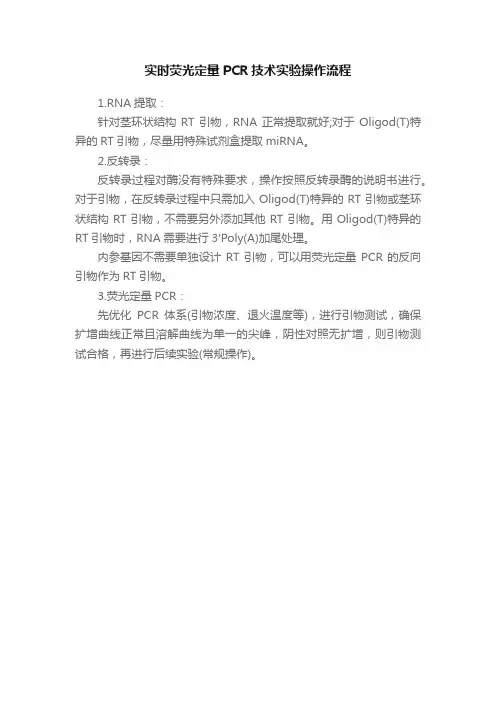
实时荧光定量PCR技术实验操作流程
1.RNA提取:
针对茎环状结构RT引物,RNA正常提取就好;对于Oligod(T)特异的RT引物,尽量用特殊试剂盒提取miRNA。
2.反转录:
反转录过程对酶没有特殊要求,操作按照反转录酶的说明书进行。
对于引物,在反转录过程中只需加入Oligod(T)特异的RT引物或茎环状结构RT引物,不需要另外添加其他RT引物。
用Oligod(T)特异的RT引物时,RNA需要进行3'Poly(A)加尾处理。
内参基因不需要单独设计RT引物,可以用荧光定量PCR的反向引物作为RT引物。
3.荧光定量PCR:
先优化PCR体系(引物浓度、退火温度等),进行引物测试,确保扩增曲线正常且溶解曲线为单一的尖峰,阴性对照无扩增,则引物测试合格,再进行后续实验(常规操作)。
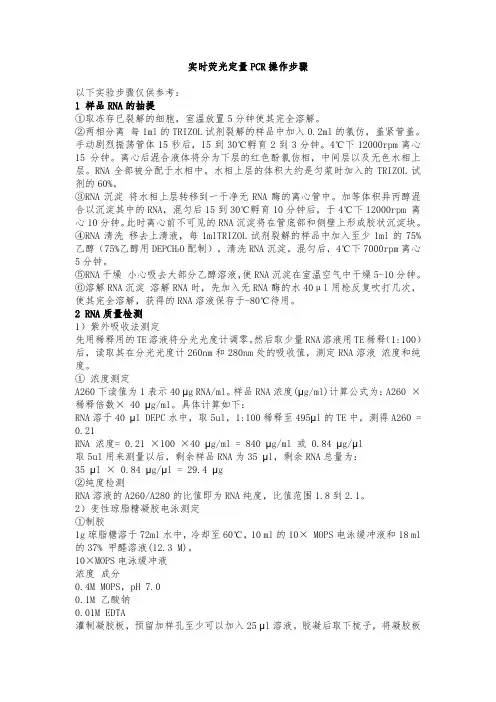
实时荧光定量PCR操作步骤以下实验步骤仅供参考:1 样品RNA的抽提①取冻存已裂解的细胞,室温放臵5分钟使其完全溶解。
②两相分离每1ml的TRIZOL试剂裂解的样品中加入0.2ml的氯仿,盖紧管盖。
手动剧烈振荡管体15秒后,15到30℃孵育2到3分钟。
4℃下12000rpm离心15分钟。
离心后混合液体将分为下层的红色酚氯仿相,中间层以及无色水相上层。
RNA全部被分配于水相中。
水相上层的体积大约是匀浆时加入的TRIZOL试剂的60%。
③RNA沉淀将水相上层转移到一干净无RNA酶的离心管中。
加等体积异丙醇混合以沉淀其中的RNA,混匀后15到30℃孵育10分钟后,于4℃下12000rpm 离心10分钟。
此时离心前不可见的RNA沉淀将在管底部和侧壁上形成胶状沉淀块。
④RNA清洗移去上清液,每1mlTRIZOL试剂裂解的样品中加入至少1ml的75%O配制),清洗RNA沉淀。
混匀后,4℃下7000rpm离心乙醇(75%乙醇用DEPCH25分钟。
⑤RNA干燥小心吸去大部分乙醇溶液,使RNA沉淀在室温空气中干燥5-10分钟。
⑥溶解RNA沉淀溶解RNA时,先加入无RNA酶的水40μl用枪反复吹打几次,使其完全溶解,获得的RNA溶液保存于-80℃待用。
2 RNA质量检测1)紫外吸收法测定先用稀释用的TE溶液将分光光度计调零。
然后取少量RNA溶液用TE稀释(1:100)后,读取其在分光光度计260nm和280nm处的吸收值,测定RNA溶液浓度和纯度。
①浓度测定A260下读值为1表示40 µg RNA/ml。
样品RNA浓度(µg/ml)计算公式为:A260 ×稀释倍数× 40 µg/ml。
具体计算如下:RNA溶于40 µl DEPC水中,取5ul,1:100稀释至495µl的TE中,测得A260 = 0.21RNA 浓度= 0.21 ×100 ×40 µg/ml = 840 µg/ml 或 0.84 µg/µl取5ul用来测量以后,剩余样品RNA为35 µl,剩余RNA总量为:35 µl × 0.84 µg/µl = 29.4 µg②纯度检测RNA溶液的A260/A280的比值即为RNA纯度,比值范围1.8到2.1。
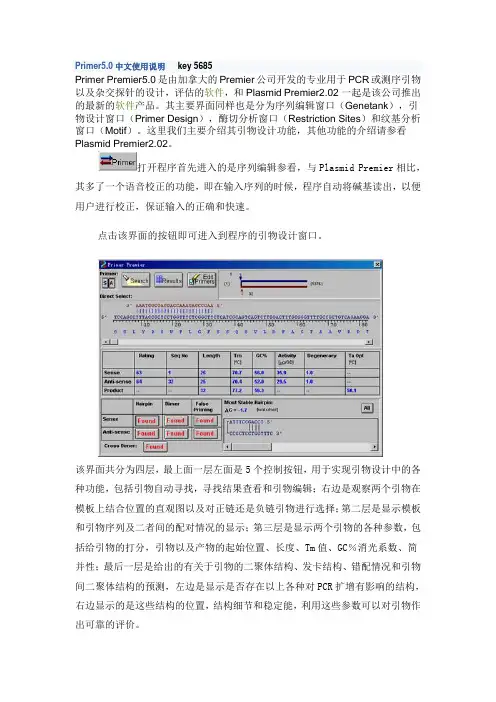
Primer5.0中文使用说明key 5685Primer Premier5.0是由加拿大的Premier公司开发的专业用于PCR或测序引物以及杂交探针的设计,评估的软件,和Plasmid Premier2.02一起是该公司推出的最新的软件产品。
其主要界面同样也是分为序列编辑窗口(Genetank),引物设计窗口(Primer Design),酶切分析窗口(Restriction Sites)和纹基分析窗口(Motif)。
这里我们主要介绍其引物设计功能,其他功能的介绍请参看Plasmid Premier2.02。
打开程序首先进入的是序列编辑参看,与Plasmid Premier相比,其多了一个语音校正的功能,即在输入序列的时候,程序自动将碱基读出,以便用户进行校正,保证输入的正确和快速。
点击该界面的按钮即可进入到程序的引物设计窗口。
该界面共分为四层,最上面一层左面是5个控制按钮,用于实现引物设计中的各种功能,包括引物自动寻找,寻找结果查看和引物编辑;右边是观察两个引物在模板上结合位置的直观图以及对正链还是负链引物进行选择;第二层是显示模板和引物序列及二者间的配对情况的显示;第三层是显示两个引物的各种参数,包括给引物的打分,引物以及产物的起始位置、长度、Tm值、GC%消光系数、简并性;最后一层是给出的有关于引物的二聚体结构、发卡结构、错配情况和引物间二聚体结构的预测,左边是显示是否存在以上各种对PCR扩增有影响的结构,右边显示的是这些结构的位置,结构细节和稳定能,利用这些参数可以对引物作出可靠的评价。
下面是根据模板序列寻找引物的界面,在该界面中可以设定所要搜索的引物的类型,包括PCR引物,测序引物和杂交探针以及引物所在的链;另外也能设定搜索引物的范围,以及最终PCR产物的长度和引物的长度等。
并通过来点击按钮来设置一些搜寻参数:这些参数包括引物的Tm值,GC比,有简并性碱基,3’端稳定性,引物的稳定性,重复序列,二聚体/发卡结构和与模板及可能的杂质DNA(需要从另外的序列文件中读入)之间的错配情况,这些参数的设定可以根据要求变化,程序本身根据一定的标准分成从极高严谨性到极低严谨性5个档次。
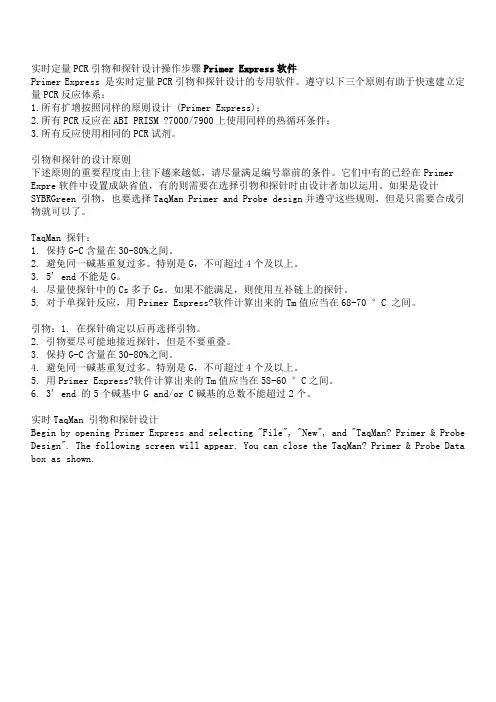
实时定量PCR引物和探针设计操作步骤Primer Express软件Primer Express 是实时定量PCR引物和探针设计的专用软件。
遵守以下三个原则有助于快速建立定量PCR反应体系:1.所有扩增按照同样的原则设计 (Primer Express);2.所有PCR反应在ABI PRISM ?7000/7900上使用同样的热循环条件;3.所有反应使用相同的PCR试剂。
引物和探针的设计原则下述原则的重要程度由上往下越来越低,请尽量满足编号靠前的条件。
它们中有的已经在Primer Expre软件中设置成缺省值,有的则需要在选择引物和探针时由设计者加以运用。
如果是设计SYBRGreen 引物,也要选择TaqMan Primer and Probe design并遵守这些规则,但是只需要合成引物就可以了。
TaqMan 探针:1. 保持G-C含量在30-80%之间。
2. 避免同一碱基重复过多。
特别是G,不可超过4个及以上。
3. 5' end不能是G。
4. 尽量使探针中的Cs多于Gs。
如果不能满足,则使用互补链上的探针。
5. 对于单探针反应,用Primer Express?软件计算出来的Tm值应当在68-70 °C 之间。
引物:1. 在探针确定以后再选择引物。
2. 引物要尽可能地接近探针,但是不要重叠。
3. 保持G-C含量在30-80%之间。
4. 避免同一碱基重复过多。
特别是G,不可超过4个及以上。
5. 用Primer Express?软件计算出来的Tm值应当在58-60 °C之间。
6. 3' end 的5个碱基中G and/or C碱基的总数不能超过2个。
实时TaqMan 引物和探针设计Begin by opening Primer Express and selecting "File", "New", and "TaqMan? Primer & Probe Design". The following screen will appear. You can close the TaqMan? Primer & Probe Data box as shown.输入或插入序列Import or paste a sequence into the window (Import shown). To paste a sequence from a Word or text file, first copy it to the clipboard. Be sure to only select the sequence (including numbers or annotations is OK); do not include extraneous information such as accession numbers etc. Next, select "Edit" and "Paste". The sequence will appear in the Sequence screen of Primer Express. Or, to Import a Sequence, click the "Import DNA File" button as shown. The software will then ask you to locate the sequence file. Select it from a folder, hard drive, disk, or desktop. Again, no annotations should be present in this sequence.A file is then imported after selecting the file location.保存输入的序列Select "File" and "Save" to give the sequence a name. This will be displayed in the File Name Box and will save the sequence in the Archive Folder.引物和探针设计参数Click the "Parameters" tab. This displays the Universal default parameters used to search for suitable TaqMan? primer & probe sets for real-time assays. It is strongly recommended that you do not adjust any of the parameters.引物和探针的排序及选择Primer Express is now ready to find Primers and Probes. Click the "Primers" tab, select "Options" and "Find Primers/Probes Now". The software will display the progress in the small window below the sequence.** Please disregard the "Optimal Primer Pairs Only" checkbox and the "Penalty" heading. By checking the Optimal Primer Pairs Only box, you will be severely limiting the range of your search, since the parameters it employs are not based on TaqMan? design guidelines. The Penalty score assigned to your Primer & Probe set is based on factors such as amplicon length. Since the default TaqMan? design parameters keep amplicons under 150 bp, this can be disregarded as well.Primer/probe sets will be listed when the search is complete. Scroll to the right to view the Probes. Click on the "Start" heading under probes to sort probes by sequence. This will group similar probes, simplifying the search.探针的选择Select a probe that is less than 30 bp in length and contains more C's than G's. The probes displayed are on the sense strand only. If the probes displayed do not have more C's than G's, then you will need to use the complement probe (as illustrated in this example). If you need to use the complement, make sure that the probe selected here does not have a C at the 3' end of the probe (otherwise, the complement will have a G at the 5' end ? whichis not allowed).The probe selected meets the first criteria above, but not the second (9 G's, 5 C's). Highlight this probe.Return to the sequence by clicking the "Sequence" tab.Lock in the probe sequence by clicking the Probe Button on the Tool Bar and highlight the probe sequence. The probe will turn green and be displayed in lower case when it is locked.引物选择Find compatible primers by returning to the "Primers" tab, selecting "Options" and "Find Primers & Probes Now". This will find new primer sets that will work with the probe you have selected. You can click on "Start" under Forward Primer to sort the displayed sequences.Search for a primer from the list displayed the meets the following criteria:1.No more than 2 G's and/or C's within the last 5 bases on the 3' end of the primer; and2.No runs of identical nucleotides, especially 4 or more G's.From the list of forward primers displayed, select a primer that has no more than 2 G's and/or C's within the last 5 bases on the 3' end of the primer. Highlight one of the primers that matches this criteria. If no forward primer matches this criteria then select a primer with 3 G's and/or C's. The example shown below matches the criteria and will serve as a suitable forward primer. Once you have selected the appropriate primer click on the "Sequence" tab to return to the Sequence window.Lock the forward primer by clicking the "Forward Primer" button on the toolbar, then highlighting the forward primer sequence. A blue arrow will be displayed under the forward primer showing that it is locked.Click on the "Primers" tab and perform a new search. Scroll to the Reverse Primers displayed and select a reverse primer following the same criteria for forward primer selection (G/C rule on the 3' end of primer).Return to the Sequence page and lock in on the Reverse Primer using the Reverse Primer Tool.This now displays the primers and probe you have selected. Return to the Primers tab and perform one final search to display your results.保存搜索结果Click on "Save List" at the bottom of the screen to save your selection in a tab delimitedformat. Click "Order" to generate an editable/printable text file of your sequences:互补探针的选择In the example above, you must use the complementary probe so as to insure that the probe has more C's than G's. Remember, the probe you use cannot have a G at the 5' end, thus the sense probe used for this search cannot have a C at the 3' end.In order to generate the probe complement, return to the Sequence screen. Highlight the probe sequence, select "Edit", and "Copy Complement". You will not see the complementary sequence at this point; it is copied to the clipboard:Return to the Order window and "Paste" the complement in this window, overwriting the probe displayed. You have the option of editing the primer/probe names, and adding the reporter/quencher dyes to the probe sequence.This document can now be saved and put into a Word document or attached to an e-mail message.在Results Archive中保存搜索结果Your search can also be saved in the Results Archive Folder. Click on the "Results" tab. The forward and reverse primers are displayed in their respective boxes, and the probe sequence is displayed in the "Cycle Params" box The probe sequence displayed is the original strand. To view/save the complementary strand, highlight the probe from the Sequence and select "Copy Complement". "Paste" the complement probe into the "Cycle Params". The complementary probe strand is now displayed. It is important to note that if you leave the Results page, the probe sequence will default back to the original. Each time you returnto the Results page you will need to re-paste the complementary probe strand. Note: The information displayed below the selected primer and probe sequences should be ignored when performing TaqMan Assays. The Universal TaqMan? Guidelines do not require you to perform optimizations, thus, the cycling/concentration, etc. information displayed here can be ignored. Save the Results by selecting "Save Results". A message will display showing the results were saved.打印结果 To print the Results, select "Open Results" from the "File" menu. The last (newest) results file will be the last one in the list (at the bottom of the list): Highlight and click "Open".This is the relevant information needed to order your primer/probe set. To print, click and drag, highlighting the information you want and selecting "Copy" from the "Edit" menu, placing it on the clipboard. This should be everything from the Sequence name through the TaqMan? probe annealing information.This is the relevant information needed to order your primer/probe set. To print, click and drag, highlighting the information you want and selecting "Copy" from the "Edit" menu, placing it on the clipboard. This should be everything from the Sequence name through the TaqMan? probe annealing information.You can then paste your sequence information in to a Word document; from here you can print a copy for your records.订购信息Be sure to include information on your needed synthesis scale and the corresponding part number, your reporter dye(s), your quencher (TAMRA), and your personal information (name, institution, address, phone fax etc.).。
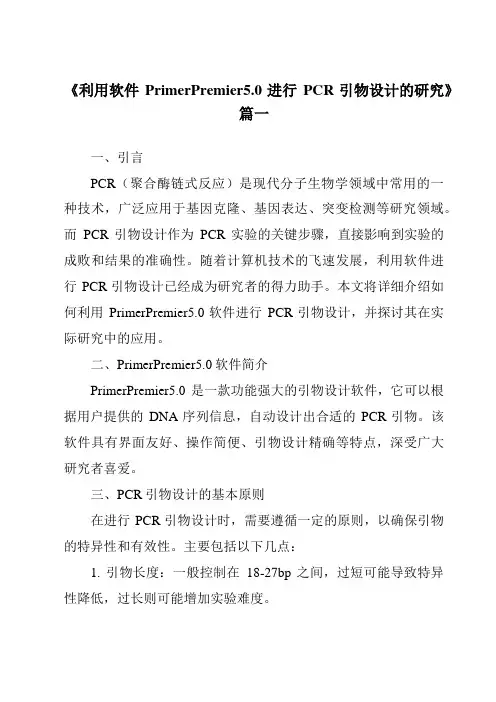
《利用软件PrimerPremier5.0进行PCR引物设计的研究》篇一一、引言PCR(聚合酶链式反应)是现代分子生物学领域中常用的一种技术,广泛应用于基因克隆、基因表达、突变检测等研究领域。
而PCR引物设计作为PCR实验的关键步骤,直接影响到实验的成败和结果的准确性。
随着计算机技术的飞速发展,利用软件进行PCR引物设计已经成为研究者的得力助手。
本文将详细介绍如何利用PrimerPremier5.0软件进行PCR引物设计,并探讨其在实际研究中的应用。
二、PrimerPremier5.0软件简介PrimerPremier5.0是一款功能强大的引物设计软件,它可以根据用户提供的DNA序列信息,自动设计出合适的PCR引物。
该软件具有界面友好、操作简便、引物设计精确等特点,深受广大研究者喜爱。
三、PCR引物设计的基本原则在进行PCR引物设计时,需要遵循一定的原则,以确保引物的特异性和有效性。
主要包括以下几点:1. 引物长度:一般控制在18-27bp之间,过短可能导致特异性降低,过长则可能增加实验难度。
2. 引物序列:应选择与模板序列高度互补的序列,以增加PCR的特异性。
3. 退火温度:应选择合适的退火温度,以保证PCR反应的稳定性和重复性。
4. 避免二级结构:引物设计时应尽量避免形成二级结构,以减少非特异性扩增的可能性。
四、利用PrimerPremier5.0进行PCR引物设计的步骤1. 打开PrimerPremier5.0软件,导入待设计的DNA序列。
2. 设置引物设计的参数,包括引物长度、GC含量、退火温度等。
3. 进行引物设计。
软件将根据设定的参数,自动在DNA序列中寻找合适的引物。
4. 查看和分析引物结果。
软件将显示所有设计的引物及其相关信息,如位置、长度、GC含量等。
研究者可以根据实际需要选择合适的引物。
5. 导出引物信息。
将选定的引物信息导出,用于PCR实验。
五、PrimerPremier5.0在PCR引物设计中的应用PrimerPremier5.0软件在PCR引物设计中具有广泛的应用。
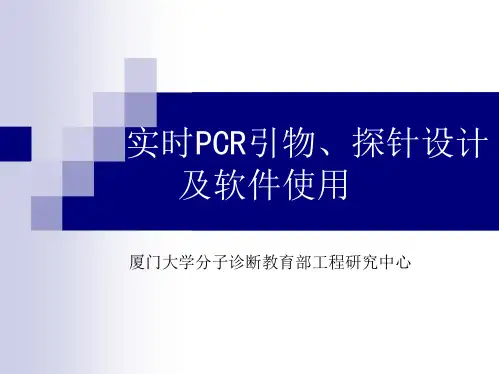
Primer Express v3.0 Primers and Probe Design For Real-Time PCRPrimers/Probes Design GuidelineTaqMan Probe Primer Probe Primer 離 , PCR 50-150 bpG/C % 30-80 %列 4 G Tm : 68-70 (Quantification assay)65-67 (Allelic Discrimination assay)Tm : 58-60Probe 度:13~25 bases (TaqMan MGB probe) 13~30 bases (TaqMan probe)Primer 度: 20 bases (Optimal)連 6 A 列5’ 列不 G( FAM-dye 5’ 列 不 G)C G strand probe b3’ 4 列裡 3 G(GGG-MGB-3’ or GGAG-MGB-3’) aprobe 2 CC di-nucleotides a3’ 列裡不 2 C+Ga: TaqMan MGB probeb: 參數Primers & Probes for QuantificationAutomatically DesignPrimer Express 3.0File→ New→ “TaqMan MGB Quantification TaqMan Quantification”→ OKTools → “Add DNA File” 列 ”Add” 列 ”Sequence” Tab Copy & Paste 列* Primer Express Software .dan, .txt, .ab1, .abi , 列” Double Strand “, double stranded DNA sequenceTools1. Exclude:不 列 利 ”Exclude Selected Bases” 列- 不 列 “Exclude” 見2. Junction: 列 junction 利 ”Junction”- juction ( 2 bases) “Junction” 見來3. ”Parameters” Tab Primer/Probe Tm Primers/Probe”Sequence” Tab Tools → Find Primers/Probes Primers/Probe pairsPrimer Express Candidate Primers & Probe pairs search 50 列 ”Primers / Probes” Tab ”Location”說 primers & probes 列 數”Sequence” Tab ”Primers / Probes” Tab Primers/Probe: Probe 藍 Forward Primer Reverse Primer (* 不 )”Primers / Probes” Tab Primers/Probe 列 來 2 primer/ probe design guideline MGB Probe ”Parameters” Tab ”C ” ” G ” 列 參數primer/ probe set 行 File → Save As primer/ probe set 利 Export → Order Info… 50 Primers/Probes Export →Primers/Probes List… 兩 都 .txt ExcelManually DesignPrimer/Probe Primer/Probe Quantification Document 列 (參 3 )1. Probe :”Sequence” Tab Probe 列highlight 來( 25 bases 度 度 列 ) 利 Edit Copy (Ctrl+C) 列 Tools→ Primer Probe Test Tool document type ( “TaqMan MGB Quantification TaqMan Quantification”) Parameter ”Default” 利 Paste (Ctrl+V) 列 Probe 1欄 列 Tm, %GC 度: probe 列不 G 列裡 C 數 G若Tm (68 to 70 ) Probe 1欄 不 列 Tm, %GC 度 Probe ( 參 primer/ probe design guideline) 若 ”Trim” 列 留 Probe 列Probe 列 ”Sequence” Tab Probe 列highlight 來 利 Edit →Annotate → ” Probe” probe 列 來 probe 綠利 Tools → Find Primers/Probes Probe Forward / Reverse Primers 若 Primers 行Forward / Reverse Primers2. Forward Primer :”Sequence” Tab Primer 列highlight 來( 25 bases 度 切 Probe 列 ) 利 Edit Copy (Ctrl+C) 列 Tools → Primer Probe Test Tool 利 Paste (Ctrl+V) 列 Fwd Primer欄 列 Tm, %GC 度Forward Primer Tm 58-60 Tm 不 Fwd Primer 不 列 Tm, %GC 度 Primer ( 參 primer/ probe design guideline) 若 ”Trim” 列 留 列Fwd Primer 列 ”Sequence” Tab 列highlight 來 利 ” Forward Primer” 來 Fwd Primer 藍3. Reverse Primer”Sequence” Tab Reverse 列highlight 來( 25 bases 度 切 Probe 列 ) 利 Edit →” Copy Complement ” 列 Tools → Primer Probe Test Tool Rev Primer欄Reverse Primer Tm 58-60 Tm 不 Rev Primer 不 列 Tm, %GC 度 Primer ( 參 primer/ probe design guideline) 若 ”Trim” 列 留 列Rev Primer 列 ”Sequence” Tab 列highlight 來 利 ” Reverse Primer” 來 Rev Primerprimer/ probe set 利 Copy & Paste text save 來 來參 料 document 行 File → Save AsSYBR Green I Primer for QuantificationAutomatically DesignPrimer Express 3.0File→ New→ “TaqMan MGB Quantification TaqMan Quantification”→ OKTools → “Add DNA File” 列 ”Add” 列 ”Sequence” Tab Copy & Paste 列* Primer Express Software .dan, .txt, .ab1, .abi , 列” Double Strand “, double stranded DNA sequenceTools1. Exclude:不 列 利 ”Exclude Selected Bases” 列- 不 列 “Exclude” 見列 junction 利 ”Junction”2. Junction:- juction ( 2 bases) “Junction” 見來3. ”Parameters” Tab Primer Tm Primers”Sequence” Tab Tools → Find Primers/Probes Primers/Probe pairsPrimer Express Candidate Primers & Probe pairs search 50 列 ”Primers / Probes” Tab 若 行SYBR Green primer 不 probe 列 參 primer 列 ”Location”說 primers & probes 列 數”Sequence” Tab ”Primers / Probes” Tab Primers/Probe: Probe 藍 Forward Primer Reverse Primer (* 不 )”Primers / Probes” Tab Primers/Probe 列 來 2 primer/ probe design guideline* SYBR Green primer primer dimer- ”Primers / Probes” Tab primer set 來 Primer Secondary Structure Hairpin, Self Dimers Cross Dimers 數 GC 例primers set 行 File → Save Asprimers set 利 Export → Order Info (50)Primers/Probes Export →Primers/Probes List… 兩 都 .txt ExcelManually DesignPrimer PrimerQuantification Document 列 (參 13 )1. Forward Primer :”Sequence” Tab Primer 列highlight 來( 25 bases 度 度 列 ) 利 Edit Copy (Ctrl+C) 列 Tools → Primer Probe Test Tool document type ( “TaqMan MGB Quantification TaqMan Quantification”) Parameter ”Default” 利 Paste (Ctrl+V) 列 Fwd Primer欄 列 Tm, %GC 度Forward Primer Tm 58-60 Tm 不 Fwd Primer 不 列 Tm, %GC 度 Primer ( 參 primer/ probe design guideline) 若 ”Trim” 列 留 列2. Reverse Primer :”Sequence” Tab Reverse 列highlight 來( 25 bases 度 度 列 ) 利 Edit →” Copy Complement ” 列 Tools → Primer Probe Test Tool Rev Primer欄Reverse Primer Tm 58-60 Tm 不 Rev Primer 不 列 Tm, %GC 度 Primer ( 參 primer/ probe design guideline) 若 ”Trim” 列 留 列3. SYBR Green primer primer dimer- Primer Probe Test Tool primer set ”Show Secondary Stucture” 來 Primers Hairpin, Self Dimers Cross Dimers 數 GC 例 primerFwd Primer 列 ”Sequence” Tab 列highlight 來 利 ” ForwardPrimer” 來 Fwd Primer 藍Rev Primer 列 ”Sequence” Tab 列highlight 來 利 ” Reverse Primer” 來 Rev Primerprimer/ probe set 利 Copy & Paste text save 來 來參 料 document 行 File → Save AsPrimers & Probes for Allelic DiscriminationAutomatically DesignPrimer Express 3.0File→ New→ “TaqMan MGB Allelic Discrimination TaqMan Allelic Discrimination”→ OK TaqMan MGB probe 更Tools → “Add DNA File” 列 ”Add” 列 ”Sequence” Tab Copy & Paste 列* Primer Express Software .dan, .txt, .ab1, .abi , 列 (若 列 database download 來 , 列 料)SNPSNP highlight Edit → Annotate → “SNP Target ” SNP 異 (variant)例 528 G/A SNP G A ”R” OK SNP rTools → Find Primers/Probes Primers/Probes pairsPrimer Express Candidate Primers & Probes pairs search 50 列 ”Primers / Probes” Tab ”Location”說 primers & probes 列 數”Sequence” Tab ”Primers / Probes” Tab Primers/Probes: Probe 1 綠 Probe 2 (2 Probe 列 綠 ) 藍 Forward Primer Reverse Primer (* 不 )”Primers / Probes” Tab Primers/Probe 列 來 2 primer/ probe design guideline MGB Probe ”Parameters” Tab ”C ” ” G ” 列 參數primer/ probe set 行 File → Save Asprimer/ probe set 利 Export → Order Info…50 Primers/Probes Export →Primers/Probes List… 兩 都 .txt ExcelManually DesignPrimer/Probe Primer/Probe Allelic Discrimination Document 列 (參 23 )1. Probe for Allele 1:”Sequence” Tab SNP highlight 來 Edit → Annotate → “SNP Target ” SNP 異 ( 參 24 ) Probe1 列highlight 來( 13~25 bases 度) 利 Edit Copy with Allele 1 (Ctrl+Shift+W) 列 Tools→ Primer Probe Test Tool document type ( “TaqMan MGB Allelic Discrimination TaqMan Allelic Discrimination”) Parameter ”Default” 利 Paste (Ctrl+V) 列 Probe1欄 Allele 1 variant base ( 例 ”g”) 列 Tm, %GC 度: probe 列不 G 列裡 C 數 G若Tm (65 to 67 ) Probe 1欄 不 列 Tm, %GC 度 Probe ( 參 primer/ probe design guideline) 若 ”Trim” 列 留 Probe 列SNPSNP Probe 列 3’ 2 base 不 兩 base2. Probe for Allele 2:”Sequence” Tab Probe2 列highlight 來( 13~25 bases 度) 利 Edit Copy with Allele 2 (Ctrl+Shift+M) 列 Tools→ Primer Probe Test Tool 利 Paste (Ctrl+V) 列 Probe2欄 Allele 2 variant base ( 例 ”a”) 列 Tm, %GC 度若Tm (65 to 67 ) Probe 1欄 不 列 Tm, %GC 度 Probe ( 參 primer/ probe design guideline) 若 ”Trim” 列 留 Probe 列 probe1 probe2 Tm 異不 1Primer :3. Forward”Sequence” Tab Primer 列highlight 來( 25 bases 度 切 Probe 列 ) 利 Edit Copy (Ctrl+C) 列 Tools → Primer Probe Test Tool 利 Paste (Ctrl+V) 列 Fwd Primer欄 列 Tm, %GC 度Forward Primer Tm 58-60 Tm 不 Fwd Primer 不 列 Tm, %GC 度 Primer ( 參 primer/ probe design guideline) 若 ”Trim” 列 留 列Primer :4. Reverse”Sequence” Tab Reverse 列highlight 來( 25 bases 度 切 Probe 列 ) 利 Edit →” Copy Complement ” 列 Tools → Primer Probe Test Tool Rev Primer欄Reverse Primer Tm 58-60 Tm 不 Rev Primer 不 列 Tm, %GC 度 Primer ( 參 primer/ probe design guideline) 若 ”Trim” 列 留 列primer/ probe set 利 Copy & Paste text save 來 來參 料 document 行 File → Save As: 0800251326e-mail TWSupport@。
实时荧光定量PCR(Quantitative Real-time PCR,QRT-PCR)的方法学建立QRT-PCR原理:在PCR反应体系中加入荧光基团,利用荧光信号积累实时监测整个PCR 进程,最后通过标准曲线对未知模板进行定量分析。
检测方法包括SYBR GreenⅠ法和TaqMan探针法,在基础研究中,应用比较广泛的为SYBR GreenⅠ法,因此,以下主要针对SYBR GreenⅠ法的方法学建立。
一、RNA的提取及质量检测Trizol法提取RNA的原理:Trizol主要物质是异硫氰酸胍,它可以破坏细胞使RNA释放出来的同时,保护RNA的完整性。
加入氯仿后离心,样品分成水样层和有机层。
RNA存在于水样层中。
收集上面的的水样层后,RNA可以通过异丙醇沉淀来还原。
1、用液氮将组织研碎,按照50-100 mg组织加入1mL的Trizol® Reagent(若样品为细胞,则按照5-10x106个细胞加入1mL的Trizol® Reagent来裂解细胞),室温裂解5 min,使核蛋白复合物充分分离。
2、每1 mL的Trizol® Reagent加入200 μl氯仿,剧烈摇晃、混匀,室温静置5 min。
于4℃离心机12000 g离心15 min,离心后,混合物分为下层(红色酚氯仿)中层和上层(无色的水相层,约占总体积的50%),RNA存留于上层水相中。
用移液器吸出样品中的水相转移至另一EP管中,勿吸出中间相和有机相。
3、按照每1 mL的Trizol® Reagent加入500 μl异丙醇,轻轻混匀,室温孵育10 min。
于4℃离心机12000 g离心10 min,RNA沉于管底,弃上清。
4、按照每1 mL的Trizol® Reagent加入500 μl 75%的乙醇洗涤RNA,于4℃离心机7500 g 离心10 min,用75%乙醇洗涤RNA两次。
5、去除管中75% 乙醇,将RNA自然晾干5 min。
PrimerExpressv3.0中⽂操作⼿册Primer Express v3.0 Primers and Probe Design For Real-Time PCR Primers/Probes Design GuidelineTaqMan Probe Primer Probe Primer 離 , PCR 50-150 bpG/C % 30-80 %列 4 G Tm : 68-70 (Quantification assay)65-67 (Allelic Discrimination assay)Tm : 58-60Probe 度:13~25 bases (TaqMan MGB probe) 13~30 bases (TaqMan probe) Primer 度: 20 bases (Optimal)連 6 A 列5’ 列不 G( FAM-dye 5’ 列不 G)C G strand probe b3’ 4 列裡 3 G(GGG-MGB-3’ or GGAG-MGB-3’) aprobe 2 CC di-nucleotides a3’ 列裡不 2 C+Ga: TaqMan MGB probeb: 參數Primers & Probes for QuantificationAutomatically DesignPrimer Express 3.0File→ New→ “TaqMan MGB Quantification TaqMan Quantification”→ OKTools → “Add DNA File” 列 ”Add” 列 ”Sequence” Tab Copy & Paste 列* Primer Express Software .dan, .txt, .ab1, .abi , 列” Double Strand “, double stranded DNA sequenceTools1. Exclude:不列利 ”Exclude Selected Bases” 列- 不列 “Exclude” ⾒2. Junction: 列 junction 利 ”Junction”- juction ( 2 bases) “Junction” ⾒來3. ”Parameters” Tab Primer/Probe Tm Primers/Probe”Sequence” Tab Tools → Find Primers/Probes Primers/Probe pairsPrimer Express Candidate Primers & Probe pairs search 50 列 ”Primers / Probes” Tab ”Location”說 primers & probes 列數”Sequence” Tab ”Primers / Probes” Tab Primers/Probe: Probe 藍 Forward Primer Reverse Primer (* 不 )”Primers / Probes” Tab Primers/Probe 列來 2 primer/ probe design guideline MGB Probe ”Parameters” Tab ”C ” ” G ” 列參數primer/ probe set ⾏ File → Save As primer/ probe set 利 Export → Order Info… 50 Primers/Probes Export →Primers/Probes List… 兩都 .txt ExcelManually DesignPrimer/Probe Primer/Probe Quantification Document 列 (參 3 )1. Probe :”Sequence” Tab Probe 列highlight 來( 25 bases 度度列 ) 利 Edit Copy (Ctrl+C) 列 Tools→ Primer Probe Test Tool document type ( “TaqMan MGB Quantification TaqMan Quantification”) Parameter ”Default” 利 Paste (Ctrl+V) 列 Probe 1欄列 Tm, %GC 度: probe 列不 G 列裡 C 數 G若Tm (68 to 70 ) Probe 1欄不列 Tm, %GC 度 Probe ( 參 primer/ probe design guideline) 若 ”Trim” 列留 Probe 列Probe 列 ”Sequence” Tab Probe 列highlight 來利 Edit →Annotate → ” Probe” probe 列來 probe 綠利 Tools → Find Primers/Probes Probe Forward / Reverse Primers 若 Primers ⾏Forward / Reverse Primers2. Forward Primer :”Sequence” Tab Primer 列highlight 來( 25 bases 度切 Probe 列 ) 利 Edit Copy (Ctrl+C) 列 Tools → Primer Probe Test Tool 利 Paste (Ctrl+V) 列 Fwd Primer欄列 Tm, %GC 度Forward Primer Tm 58-60 Tm 不 Fwd Primer 不列 Tm, %GC 度 Primer ( 參 primer/ probe design guideline) 若 ”Trim” 列留列Fwd Primer 列 ”Sequence” Tab 列highlight 來利 ” Forward Primer” 來 Fwd Primer 藍3. Reverse Primer”Sequence” Tab Reverse 列highlight 來( 25 bases 度切 Probe 列 ) 利 Edit →” Copy Complement ” 列 Tools → Primer Probe Test Tool Rev Primer欄Reverse Primer Tm 58-60 Tm 不 Rev Primer 不列 Tm, %GC 度 Primer ( 參 primer/ probe design guideline) 若 ”Trim” 列留列Rev Primer 列 ”Sequence” Tab 列highlight 來利 ” Reverse Primer” 來 Rev Primerprimer/ probe set 利 Copy & Paste text save 來來參料 document ⾏ File → Save AsSYBR Green I Primer for QuantificationAutomatically DesignPrimer Express 3.0File→ New→ “TaqMan MGB Quantification TaqMan Quantification”→ OKTools → “Add DNA File” 列 ”Add” 列 ”Sequence” Tab Copy & Paste 列* Primer Express Software .dan, .txt, .ab1, .abi , 列” Double Strand “, double stranded DNA sequenceTools1. Exclude:不列利 ”Exclude Selected Bases” 列- 不列 “Exclude” ⾒列 junction 利 ”Junction”2. Junction:- juction ( 2 bases) “Junction” ⾒來3. ”Parameters” Tab Primer Tm Primers”Sequence” Tab Tools → Find Primers/Probes Primers/Probe pairsPrimer Express Candidate Primers & Probe pairs search 50 列 ”Primers / Probes” Tab 若⾏SYBR Green primer 不 probe 列參 primer 列 ”Location”說 primers & probes 列數”Sequence” Tab ”Primers / Probes” Tab Primers/Probe: Probe 藍 Forward Primer Reverse Primer (* 不 )”Primers / Probes” Tab Primers/Probe 列來 2 primer/ probe design guideline* SYBR Green primer primer dimer- ”Primers / Probes” Tab primer set 來 Primer Secondary Structure Hairpin, Self Dimers Cross Dimers 數 GC 例primers set ⾏ File → Save Asprimers set 利 Export → Order Info (50)Primers/Probes Export →Primers/Probes List… 兩都 .txt ExcelManually DesignPrimer PrimerQuantification Document 列 (參 13 )1. Forward Primer :”Sequence” Tab Primer 列highlight 來( 25 bases 度度列 ) 利 Edit Copy (Ctrl+C) 列 Tools → Primer Probe Test Tool document type ( “TaqMan MGB Quantification TaqMan Quantification”) Parameter ”Default” 利 Paste (Ctrl+V) 列 Fwd Primer 欄列 Tm, %GC 度Forward Primer Tm 58-60 Tm 不 Fwd Primer 不列 Tm, %GC 度 Primer ( 參 primer/ probe design guideline) 若 ”Trim” 列留列。
半定量和实时定量PCR步骤实验原理:RT-PCR将以RNA为模板的cDNA合成同PCR结合在一起,提供了一种分析基因表达的快速灵敏的方法。
RT-PCR用于对表达信息进行检测或定量。
另外,这项技术还可以用来检测基因表达差异或不必构建cDNA 文库克隆cDNA。
RT-PCR比其他包括Northern印迹、RNase保护分析、原位杂交及S1核酸酶分析在内的RNA分析技术,更灵敏,更易于操作。
RT-PCR的模板可以为总RNA或poly(A)+选择性RNA。
逆转录反应可以使用逆转录酶,以随机引物、oligo(dT)或基因特异性的引物(GSP)起始。
RT-PCR可以一步法或两步法的形式进行。
在两步法RT-PCR 中,每一步都在最佳条件下进行。
cDNA的合成首先在逆转录缓冲液中进行,然后取出1/10的反应产物进行PCR。
在一步法RT-PCR中,逆转录和PCR在同时为逆转录和PCR优化的条件下,在一只管中顺次进行。
实验步骤:Trizol法RNA提取步骤1、提取总RNA2、逆转录反应3、PCR反应以下实验步骤仅供参考:1 样品RNA的抽提①取冻存已裂解的细胞,室温放置5分钟使其完全溶解。
②两相分离每1ml的TRIZOL试剂裂解的样品中加入0.2ml的氯仿,盖紧管盖。
手动剧烈振荡管体15秒后,15到30℃孵育2到3分钟。
4℃下12000rpm离心15分钟。
离心后混合液体将分为下层的红色酚氯仿相,中间层以及无色水相上层。
RNA全部被分配于水相中。
水相上层的体积大约是匀浆时加入的TRIZOL 试剂的60%。
③RNA沉淀将水相上层转移到一干净无RNA酶的离心管中。
加等体积异丙醇混合以沉淀其中的RNA,混匀后15到30℃孵育10分钟后,于4℃下12000rpm 离心10分钟。
此时离心前不可见的RNA沉淀将在管底部和侧壁上形成胶状沉淀块。
④RNA清洗移去上清液,每1mlTRIZOL试剂裂解的样品中加入至少1ml的75%乙醇(75%乙醇用DEPCH2O配制),清洗RNA沉淀。
《利用软件PrimerPremier5.0进行PCR引物设计的研究》篇一一、引言PCR(聚合酶链式反应)是分子生物学和遗传学中常用的一种实验技术,它对于特定基因序列的克隆、分析、鉴定和扩增具有重要意义。
在PCR技术中,引物设计是一个关键的步骤,其成功与否直接影响着PCR反应的效果和准确度。
随着生物信息学的发展,引物设计软件为研究人员提供了更加方便快捷的途径。
本篇文章旨在研究并阐述如何利用软件PrimerPremier5.0进行PCR引物设计。
二、PrimerPremier5.0简介PrimerPremier5.0是一款专门用于设计PCR引物的软件,具有友好的界面和强大的功能。
它可以针对特定基因序列进行引物设计,同时还可以根据用户的需求进行参数调整,如引物的长度、GC含量、退火温度等。
此外,该软件还具有自动筛选和优化引物的功能,大大提高了引物设计的效率和准确性。
三、利用PrimerPremier5.0进行PCR引物设计的步骤1. 打开PrimerPremier5.0软件,输入需要设计的基因序列。
2. 根据实验需求设置引物设计的参数,如引物长度、GC含量、退火温度等。
3. 软件将自动分析基因序列,并在可能的位置设计引物。
用户可以根据需要调整引物的位置和参数。
4. 软件将给出所有可能的引物组合,用户可以根据引物的质量、特异性等指标进行筛选。
5. 对筛选出的引物进行优化,如调整引物的长度、GC含量等,以提高PCR反应的效率和准确性。
6. 保存并导出设计的引物序列,用于后续的PCR实验。
四、注意事项1. 在进行引物设计时,应尽量选择特异性较高的区域进行设计,以避免非特异性扩增。
2. 引物的长度和GC含量应适中,以保证PCR反应的效率和准确性。
3. 退火温度是PCR反应中一个重要的参数,应根据引物的具体情况进行调整。
4. 在使用PrimerPremier5.0进行引物设计时,应遵循软件的操作指南,以保证设计的准确性和效率。
实时定量PCR引物和探针设计操作步骤Primer Express软件Primer Express 是实时定量PCR引物和探针设计的专用软件。
遵守以下三个原则有助于快速建立定量PCR反应体系:1.所有扩增按照同样的原则设计 (Primer Express);2.所有PCR反应在ABI PRISM ?7000/7900上使用同样的热循环条件;3.所有反应使用相同的PCR试剂。
引物和探针的设计原则下述原则的重要程度由上往下越来越低,请尽量满足编号靠前的条件。
它们中有的已经在Primer Expre软件中设置成缺省值,有的则需要在选择引物和探针时由设计者加以运用。
如果是设计SYBRGreen 引物,也要选择TaqMan Primer and Probe design并遵守这些规则,但是只需要合成引物就可以了。
TaqMan 探针:1. 保持G-C含量在30-80%之间。
2. 避免同一碱基重复过多。
特别是G,不可超过4个及以上。
3. 5' end不能是G。
4. 尽量使探针中的Cs多于Gs。
如果不能满足,则使用互补链上的探针。
5. 对于单探针反应,用Primer Express?软件计算出来的Tm值应当在68-70 °C 之间。
引物:1. 在探针确定以后再选择引物。
2. 引物要尽可能地接近探针,但是不要重叠。
3. 保持G-C含量在30-80%之间。
4. 避免同一碱基重复过多。
特别是G,不可超过4个及以上。
5. 用Primer Express?软件计算出来的Tm值应当在58-60 °C之间。
6. 3' end 的5个碱基中G and/or C碱基的总数不能超过2个。
实时TaqMan 引物和探针设计Begin by opening Primer Express and selecting "File", "New", and "TaqMan? Primer & Probe Design". The following screen will appear. You can close the TaqMan? Primer & Probe Data box as shown.输入或插入序列Import or paste a sequence into the window (Import shown). To paste a sequence from a Word or text file, first copy it to the clipboard. Be sure to only select the sequence (including numbers or annotations is OK); do not include extraneous information such as accession numbers etc. Next, select "Edit" and "Paste". The sequence will appear in the Sequence screen of Primer Express. Or, to Import a Sequence, click the "Import DNA File" button as shown. The software will then ask you to locate the sequence file. Select it from a folder, hard drive, disk, or desktop. Again, no annotations should be present in this sequence.A file is then imported after selecting the file location.保存输入的序列Select "File" and "Save" to give the sequence a name. This will be displayed in the File Name Box and will save the sequence in the Archive Folder.引物和探针设计参数Click the "Parameters" tab. This displays the Universal default parameters used to search for suitable TaqMan? primer & probe sets for real-time assays. It is strongly recommended that you do not adjust any of the parameters.引物和探针的排序及选择Primer Express is now ready to find Primers and Probes. Click the "Primers" tab, select "Options" and "Find Primers/Probes Now". The software will display the progress in the small window below the sequence.** Please disregard the "Optimal Primer Pairs Only" checkbox and the "Penalty" heading. By checking the Optimal Primer Pairs Only box, you will be severely limiting the range of your search, since the parameters it employs are not based on TaqMan? design guidelines. The Penalty score assigned to your Primer & Probe set is based on factors such as amplicon length. Since the default TaqMan? design parameters keep amplicons under 150 bp, this can be disregarded as well.Primer/probe sets will be listed when the search is complete. Scroll to the right to view the Probes. Click on the "Start" heading under probes to sort probes by sequence. This will group similar probes, simplifying the search.探针的选择Select a probe that is less than 30 bp in length and contains more C's than G's. The probes displayed are on the sense strand only. If the probes displayed do not have more C's than G's, then you will need to use the complement probe (as illustrated in this example). If you need to use the complement, make sure that the probe selected here does not have a C at the 3' end of the probe (otherwise, the complement will have a G at the 5' end ? whichis not allowed).The probe selected meets the first criteria above, but not the second (9 G's, 5 C's). Highlight this probe.Return to the sequence by clicking the "Sequence" tab.Lock in the probe sequence by clicking the Probe Button on the Tool Bar and highlight the probe sequence. The probe will turn green and be displayed in lower case when it is locked.引物选择Find compatible primers by returning to the "Primers" tab, selecting "Options" and "Find Primers & Probes Now". This will find new primer sets that will work with the probe you have selected. You can click on "Start" under Forward Primer to sort the displayed sequences.Search for a primer from the list displayed the meets the following criteria:1.No more than 2 G's and/or C's within the last 5 bases on the 3' end of the primer; and2.No runs of identical nucleotides, especially 4 or more G's.From the list of forward primers displayed, select a primer that has no more than 2 G's and/or C's within the last 5 bases on the 3' end of the primer. Highlight one of the primers that matches this criteria. If no forward primer matches this criteria then select a primer with 3 G's and/or C's. The example shown below matches the criteria and will serve as a suitable forward primer. Once you have selected the appropriate primer click on the "Sequence" tab to return to the Sequence window.Lock the forward primer by clicking the "Forward Primer" button on the toolbar, then highlighting the forward primer sequence. A blue arrow will be displayed under the forward primer showing that it is locked.Click on the "Primers" tab and perform a new search. Scroll to the Reverse Primers displayed and select a reverse primer following the same criteria for forward primer selection (G/C rule on the 3' end of primer).Return to the Sequence page and lock in on the Reverse Primer using the Reverse Primer Tool.This now displays the primers and probe you have selected. Return to the Primers tab and perform one final search to display your results.保存搜索结果Click on "Save List" at the bottom of the screen to save your selection in a tab delimitedformat. Click "Order" to generate an editable/printable text file of your sequences:互补探针的选择In the example above, you must use the complementary probe so as to insure that the probe has more C's than G's. Remember, the probe you use cannot have a G at the 5' end, thus the sense probe used for this search cannot have a C at the 3' end.In order to generate the probe complement, return to the Sequence screen. Highlight the probe sequence, select "Edit", and "Copy Complement". You will not see the complementary sequence at this point; it is copied to the clipboard:Return to the Order window and "Paste" the complement in this window, overwriting the probe displayed. You have the option of editing the primer/probe names, and adding the reporter/quencher dyes to the probe sequence.This document can now be saved and put into a Word document or attached to an e-mail message.在Results Archive中保存搜索结果Your search can also be saved in the Results Archive Folder. Click on the "Results" tab. The forward and reverse primers are displayed in their respective boxes, and the probe sequence is displayed in the "Cycle Params" box The probe sequence displayed is the original strand. To view/save the complementary strand, highlight the probe from the Sequence and select "Copy Complement". "Paste" the complement probe into the "Cycle Params". The complementary probe strand is now displayed. It is important to note that if you leave the Results page, the probe sequence will default back to the original. Each time you returnto the Results page you will need to re-paste the complementary probe strand. Note: The information displayed below the selected primer and probe sequences should be ignored when performing TaqMan Assays. The Universal TaqMan? Guidelines do not require you to perform optimizations, thus, the cycling/concentration, etc. information displayed here can be ignored. Save the Results by selecting "Save Results". A message will display showing the results were saved.打印结果 To print the Results, select "Open Results" from the "File" menu. The last (newest) results file will be the last one in the list (at the bottom of the list): Highlight and click "Open".This is the relevant information needed to order your primer/probe set. To print, click and drag, highlighting the information you want and selecting "Copy" from the "Edit" menu, placing it on the clipboard. This should be everything from the Sequence name through the TaqMan? probe annealing information.This is the relevant information needed to order your primer/probe set. To print, click and drag, highlighting the information you want and selecting "Copy" from the "Edit" menu, placing it on the clipboard. This should be everything from the Sequence name through the TaqMan? probe annealing information.You can then paste your sequence information in to a Word document; from here you can print a copy for your records.订购信息Be sure to include information on your needed synthesis scale and the corresponding part number, your reporter dye(s), your quencher (TAMRA), and your personal information (name, institution, address, phone fax etc.).。